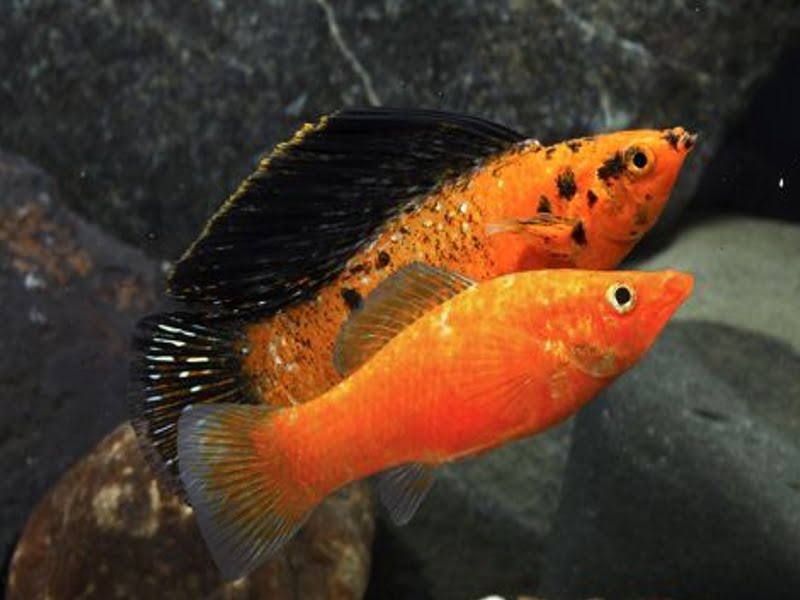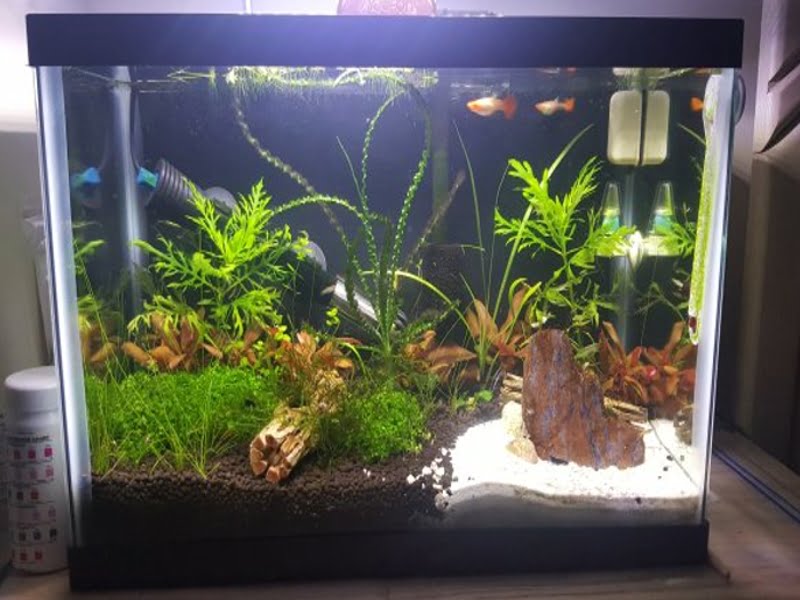Here are the four most important things you need to know about orange and black molly fish. This fish species is a common choice for every aquarist, from beginners to professionals. But if you have never taken care of one before, getting to know their preferred living conditions is essential to keep them healthy as long as possible. I will tell you how to identify the males from females, take care of them, and detect abnormalities in this species.
Related Articles
- Chocolate Molly Fish Facts: Care, Diet And Tank Mates
- Platinum Molly Fish Profile: Care, Food, Breeding, Tank And More!
- Black Molly Fish Male And Female: How To Determine & Important Notices
- Blue Molly Fish: A Rare Hue, 3 Detail Cases & Care Guidelines
- Orange Molly Fish: Why It Is A Top Selection Includes An Unique Case
- Molly Fish White – The Perfect Fish For Every Aquarium
Identify Male And Female Orange And Black Molly Fish
Here are 5 most common aspects that tell male orange and black molly fish from females.
Body Shape And Size
When comparing mollies’ body shape and size, you should make sure that every fish in the tank belongs to the same breeding period. Having fish from mixed development stage will make size comparison inaccurate.
Adult female mollies have slightly bulkier bellies than the males and have an overall rounded body shape. On the contrary, male mollies have slimmer bodies with not so visible bellies.
As for the size of the two sexes, an average male molly grows up to about 3.5 inches, while an adult female can reach 4.5 inches in length. These are pretty big community fish, so it’s best to put them in a spacious aquarium. If you want to keep 4 mollies in 3 female: 1 male ratio, it’s advisable to have a 15 to 20-gallon tank so that they can swim with ease.
Dorsal Fin
Male mollies have a fan-shaped dorsal fin, which is very flowy underwater. The fin’s size is more extensive compared to that of a female. Female mollies’ dorsal fins are rougher looking and don’t have the flowy effect to them. Many aquarists prefer keeping male mollies for this aspect. Female mollies, guppies, swordtails, etc., always look less flashy than their male counterparts.

Anal Fin
The same goes for the anal fins. Female mollies have round-shaped anal fins that help stabilize their swimming movements. As for male ones, their anal fins are called a gonopodium. They usually have a rod-like shape and work as a sex organs. Male mollies, when mating, will touch the underside of the females with this part to transfer the sperms in for reproductive purposes.
Aggressive Or Non-Aggressive
Male mollies are more aggressive than females. Males will fight each other if they have to compete for a female’s attention. What are the signs? If you see 2 or more mollies swimming quickly against each other and wagging their tails towards others frequently, chances are they are fighting.
Check for mollies with damaged fins or abnormal swimming patterns and remove them from the tank for better care. And make sure to keep your eyes on other males in the tank to identify the culprit.
When there are aggressive males in the tank, the stress level will increase and might cause diseases. Some may die quicker before reaching their average 4 years lifespan.
Gravid Spot (Less Recommended Method)
Personally, I don’t highly recommend identifying a female molly by observing if she has a gravid spot. But this method is still valid when deciding if your molly is a pregnant female or a sick and bloated male.
The gravid spot locates near the anal fin, and only females have it. When a female fish is pregnant, the gravid spot turns darker, almost black, so it’s effortless to identify it in this stage. However, in normal conditions where female mollies aren’t pregnant, the spot only is slightly more pronounced than their body color.
Why don’t I recommend this identification method as much as others? Since we are looking at orange and black molly fish, it might not be a piece of cake to decide if the black spot near the anal fin is a gravid spot (or fish womb) or simply is a black fish scale. Therefore, I suggest checking for the gravid spot when you doubt if a molly is pregnant or not. In other cases, I believe other methods are easier to apply.
How To Care For Orange And Black Molly Fish
There are 3 things you need to pay attention to when you want to keep an aquarium of mollies.
Food
Mollies mostly consume plant-based food. They will actively consume algae that develop within the tank. Romaine lettuce and zucchini also are standard options for feeding mollies. You can also choose flake food with added proteins and other healthy components that keep the fish healthy and intensify their coloration.
Tank Condition

On average, an adult molly grows up to 4.5 inches in length. And you already know the rule, each inch of a fish needs one gallon of water to develop decently. So a 4-inch female molly will need 4 gallons of water to swim comfortably.
So when you pick an aquarium for mollies, make sure that you keep in mind the size of the fish compared to the tank’s volume and the accessories you want to add because they obviously occupy space.
Also, the male-to-female ratio is significant for tank members’ physical and mental health. It’s recommended to have 3 females per male to avoid competition between the gentlemen.
Water Temperature
Since mollies are tropical fish, they won’t survive if the water temperature is too low. They thrive best in 75°-81°F water, which means you will need a heater that maintains the water temperature stable at this level. A hotter or colder temp will kill the entire community. The pH level of water between 7.5 and 8.5 is recommended for this species.
Safety
If you wish for all the mollies to grow in harmony and survive in the same tank, make sure you provide them with some hiding spots. You can put underwater greens or artificial decorations where the weak or young can hide under attacks.
Furthermore, it’s crucial to separate the females from their fries right after giving birth. Why? Because mollies feed on their young very regularly. Sometimes it’s due to the lack of food. Many times it’s because it’s a part of their nature. My suggestion is that you remove the pregnant females from the tank and keep them in a breed tank.
After they give birth to young mollies, remove them from said tank and add them back to the old tank or give them their own space for a while to heal. The risk of bringing them back to the old tank immediately is that the males may want to
Video: Orange & Black Molly Fish
FAQs
How big do orange and black mollies get?
Mollies can get quite big, up to 4.5 inches. Just like most fish species, female mollies are mostly bigger than males. Male ones grow up to 3.5 inches in length on average, which means they are smaller than females by 1 inch, typically.
How to breed orange and black molly fish?
A pair of orange and black mollies will give birth to fries of the same color. Since male and female mollies have the same level of colorfulness, the male won’t be the one to decide the color of the young totally. To make sure that the young inherit as much color as possible, you just have to ensure that the mother doesn’t get stressed.
How can you tell if an orange and black molly is pregnant?
Pregnant mollies will exhibit changes in behavior. They become more aggressive, hide more and eat slightly less. Check for the gravid spot right next to the anal fin. If the spot appears dark and highly visible, the female molly may be pregnant. And, of course, if her belly looks bulky, it’s a clear sign of pregnancy.
Where can I buy orange and black molly fish?
eBay, AquariumFish, Arizona Aquatic Gardens, and LiveAquaria are some of the trustworthy stores where you can purchase orange and black molly fish. The prices are quite reasonable, the fish are healthy, and you can order them online.

Annette M. Chaney is an experienced marine biologist with over 20 years of experience as an aquarist and fishkeeper. She started her first aquarium at a young age, filling it with frogs and goldfish obtained from the ten-cent pet store.
Annette grew up caring for and breeding African Cichlids, which led to a hobby in high school that doubled as a profitable means. Attending Reed College gave her time to solidify herself as an accomplished aquarium caretaker with an eye for sales. After that, from 2009 – 2013, she studied at Roger Williams University – one of the most prestigious universities for Aquaculture and Aquarium in USA. She is the founder of AquariumCircle since 2010.
